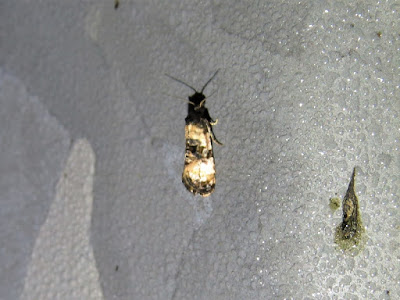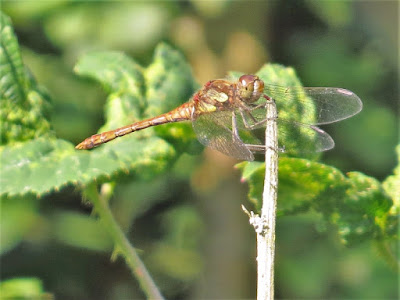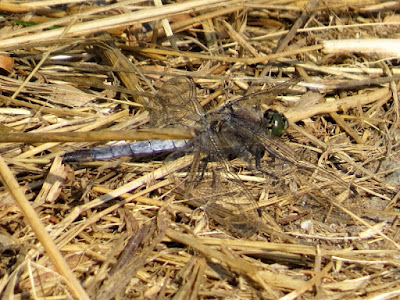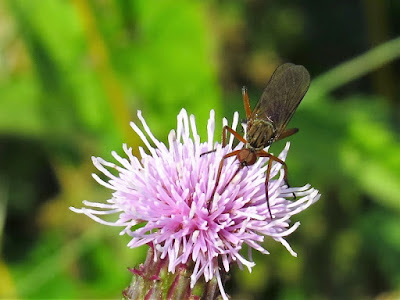10.0°C > 16.0°C: A few areas of medium/low cloud burnt off. A few fluffy bits later. Light and variable wind. Good visibility.
Sunrise: 05:31 BST
* = a photo today
Priorslee Lake: 04:25 – 05:50 // 07:00 – 09:55
Priorslee Lake: 04:25 – 05:50 // 07:00 – 09:55
(164th visit of the year)
Bird notes:
- The Canada Geese have found somewhere to the NNE to go to feed and many were heard passing below the tree line from all the vantage points I chose.
- One Cormorant had arrived by the time I returned from The Flash. Later a group of ten flew from the NE with two peeling off to briefly fish in the lake and after some hesitation the others carried on. All had gone from the lake soon after.
Overhead:
- >68 Canada Geese: 68 outbound in four groups; many more heard
- >68 Greylag Geese: 63 outbound in six groups; five inbound together; more heard
- 1 Feral Pigeon
- 2 Stock Doves: together
- 72 Wood Pigeons
- 8 Cormorants
- no Jackdaws
- 3 Rooks
- 4 Starlings: together
Hirundines etc., noted:
- House Martins only seen over Woodhouse Lane
Warblers noted:
I spent less time searching for warblers after my extended visit to Woodhouse Lane
- *7 Chiffchaffs
- 1 Sedge Warbler
- 5 Reed Warblers
- 2 Blackcaps again
- 2 Garden Warblers
Count from the lake area:
- 2 + 4 (1 brood) Mute Swans
- 8 (?♂) Mallard
- 2 + 1 (1 brood) Moorhen
- 57 Coots: adults and immatures
- Little Grebe: heard only
- 7 + 3 (2 broods) Great Crested Grebes again
- *73 Black-headed Gulls: two juveniles
- 3 Cormorants: arrived and departed
- 1 Grey Heron again
On / around the street lamps pre-dawn:
Bird notes:
- The Canada Geese have found somewhere to the NNE to go to feed and many were heard passing below the tree line from all the vantage points I chose.
- One Cormorant had arrived by the time I returned from The Flash. Later a group of ten flew from the NE with two peeling off to briefly fish in the lake and after some hesitation the others carried on. All had gone from the lake soon after.
Overhead:
- >68 Canada Geese: 68 outbound in four groups; many more heard
- >68 Greylag Geese: 63 outbound in six groups; five inbound together; more heard
- 1 Feral Pigeon
- 2 Stock Doves: together
- 72 Wood Pigeons
- 8 Cormorants
- no Jackdaws
- 3 Rooks
- 4 Starlings: together
Hirundines etc., noted:
- House Martins only seen over Woodhouse Lane
Warblers noted:
I spent less time searching for warblers after my extended visit to Woodhouse Lane
- *7 Chiffchaffs
- 1 Sedge Warbler
- 5 Reed Warblers
- 2 Blackcaps again
- 2 Garden Warblers
Count from the lake area:
- 2 + 4 (1 brood) Mute Swans
- 8 (?♂) Mallard
- 2 + 1 (1 brood) Moorhen
- 57 Coots: adults and immatures
- Little Grebe: heard only
- 7 + 3 (2 broods) Great Crested Grebes again
- *73 Black-headed Gulls: two juveniles
- 3 Cormorants: arrived and departed
- 1 Grey Heron again
On / around the street lamps pre-dawn:
Moths:
- *1 probably Notocelia sp., perhaps Triple-blotched Bell (N. trimaculana)
- 1 possible Hemp-agrimony Plume (Adaina microdactyla)
- 1 Common Grass-veneer (Agriphila tristella)
- *1 unknown 'carpet moth' type
- *1 Willow Beauty (Peribatodes rhomboidaria)
- *1 probably Notocelia sp., perhaps Triple-blotched Bell (N. trimaculana)
- 1 possible Hemp-agrimony Plume (Adaina microdactyla)
- 1 Common Grass-veneer (Agriphila tristella)
- *1 unknown 'carpet moth' type
- *1 Willow Beauty (Peribatodes rhomboidaria)
and
- 1 Wasp sp.: seemed too small for a Common Wasp
- 1 caddis fly sp.
- *1 mayfly sp.
- 2 Bridge Orb-web Spiders (Larinioides sclopetarius)
- 1 Dicranopalpus ramosus agg. harvestman
- *3 Leiobunum rotundum/blackwalli harvestmen
Yesterday's recorded Stretch spider (Tetragnatha sp.) was exactly that. An adult male and hence the enlarged palps.
In the sailing club shelter pre-dawn:
- 1 Wasp sp.: seemed too small for a Common Wasp
- 1 caddis fly sp.
- *1 mayfly sp.
- 2 Bridge Orb-web Spiders (Larinioides sclopetarius)
- 1 Dicranopalpus ramosus agg. harvestman
- *3 Leiobunum rotundum/blackwalli harvestmen
Yesterday's recorded Stretch spider (Tetragnatha sp.) was exactly that. An adult male and hence the enlarged palps.
In the sailing club shelter pre-dawn:
Spiders:
- >3 Bridge Orb-web Spiders (Larinioides sclopetarius)
- *1 Walnut orb weaver spider (Nuctenea umbratica)
- >3 Bridge Orb-web Spiders (Larinioides sclopetarius)
- *1 Walnut orb weaver spider (Nuctenea umbratica)
Feedback: Yesterday's 'sheet-web spider' has been identified as one of the Eritigena group of spiders with E. duellica, E. atrica and E. saeva all possibilities. E. duellica used to be named Tegenaria gigantea, the Large House Spider but the taxonomists have been at work.... Another, equally unidentifiable spider in this group was on a lamp pole yesterday. Thanks to Nigel as usual for the identification and information.
Other things seen later: (includes all Woodhouse Lane sightings though only the Black-tailed Skimmer was not also seen around the lake]
Other things seen later: (includes all Woodhouse Lane sightings though only the Black-tailed Skimmer was not also seen around the lake]
Butterflies:
Despite there being a large Buddleia bush alongside Teece Drive there are no Red Admiral-type butterflies around at the moment. I read that many caterpillars perished in the cold and wet Spring.
- Small White (Pieris rapae)
- Green-veined White (Pieris napi)
- Speckled Wood (Pararge aegeria)
- *Meadow Brown (Maniola jurtina)
- Gatekeeper (Pyronia tithonus)
- Common Blue (Polyommatus icarus)
Despite there being a large Buddleia bush alongside Teece Drive there are no Red Admiral-type butterflies around at the moment. I read that many caterpillars perished in the cold and wet Spring.
- Small White (Pieris rapae)
- Green-veined White (Pieris napi)
- Speckled Wood (Pararge aegeria)
- *Meadow Brown (Maniola jurtina)
- Gatekeeper (Pyronia tithonus)
- Common Blue (Polyommatus icarus)
Moths:
- Pale Straw Pearl (Udea lutealis)
- Mother of Pearl (Pleuroptya ruralis): one day one will sit still and allow a photo
- Brimstone Moth (Opisthograptis luteolata)
- Pale Straw Pearl (Udea lutealis)
- Mother of Pearl (Pleuroptya ruralis): one day one will sit still and allow a photo
- Brimstone Moth (Opisthograptis luteolata)
Bees / Wasps etc.:
- Garden Bumblebee (Bombus hortorum)
- Red-tailed Bumblebee (Bombus lapidarius)
- Common Carder Bee (Bombus pascuorum)
- Common Wasp (Paravespula vulgaris)
- Garden Bumblebee (Bombus hortorum)
- Red-tailed Bumblebee (Bombus lapidarius)
- Common Carder Bee (Bombus pascuorum)
- Common Wasp (Paravespula vulgaris)
Hoverflies:
- *Marmalade Hoverfly (Episyrphus balteatus)
- Stripe-faced Dronefly (Eristalis nemorum)
- Tapered Dronefly (Eristalis pertinax)
- Common Dronefly (Eristalis tenax)
- Chequered Hoverfly (Melanostoma scalare)
- Dead-head Hoverfly (Myathropa florea) [Batman Hoverfly]
- Syrphus sp. (S. ribesii / S. vitripennis)
- Pellucid Fly (Volucella pellucens) [Pied Plumehorn]
- *Marmalade Hoverfly (Episyrphus balteatus)
- Stripe-faced Dronefly (Eristalis nemorum)
- Tapered Dronefly (Eristalis pertinax)
- Common Dronefly (Eristalis tenax)
- Chequered Hoverfly (Melanostoma scalare)
- Dead-head Hoverfly (Myathropa florea) [Batman Hoverfly]
- Syrphus sp. (S. ribesii / S. vitripennis)
- Pellucid Fly (Volucella pellucens) [Pied Plumehorn]
Damsel-/Dragon-flies:
- Common Blue Damselfly (Enallagma cyathigerum): one only!
- *Black-tailed Skimmer (Orthetrum cancellatum)
- *Common Darter (Sympetrum striolatum)
- Brown Hawker (Aeshna grandis)
- Common Blue Damselfly (Enallagma cyathigerum): one only!
- *Black-tailed Skimmer (Orthetrum cancellatum)
- *Common Darter (Sympetrum striolatum)
- Brown Hawker (Aeshna grandis)
Other flies:
- *Dagger fly Empis livida
- *Dagger fly Empis livida
Bugs:
- *Potato Capsid (Closterotomus norwegicus)
- *Common Green Capsid (Lygocoris pabulinus)
- *Potato Capsid (Closterotomus norwegicus)
- *Common Green Capsid (Lygocoris pabulinus)
Beetles:
- Harlequin Ladybird (Harmonia axyridis): succinea form adults
- Harlequin Ladybird (Harmonia axyridis): succinea form adults
Molluscs:
- White-lipped Snails (Cepaea hortensis) as ever
- White-lipped Snails (Cepaea hortensis) as ever
Mammals:
- 1 Grey Squirrel again
- 1 Grey Squirrel again
Talk about scruffy! A Black-headed Gull with just three retained old outer primaries and six inner ones still re-growing. The tail is a mess too with several feathers moulted.
It is hard to get warbler photos at the moment – they are all buried in vegetation feeding up before they migrate – and there are too many leaves! This Chiffchaff popped out to have its photo taken.
What a few days wear and tear can do – a distinctly worn Meadow Brown butterfly (Maniola jurtina).
And a rather smarter individual. The comparison is not quite fair as this is a female with the orange panel in the upper wing. The worn specimen is a male. Note especially on the right hand wing of the female you might be tempted to wonder whether there are two white spots on the black mark. Gatekeepers have more extensive orange in the upper wing and are noticeably smaller.
A micro-moth on a lamp pole and a bit far up to get a crisp shot. I think one of the Notocelia group, none of which I am familiar with. Seems most likely to be Triple-blotched Bell (N. trimaculana), associated with Hawthorn. Similar species are associated with Dog Rose which is abundant in the area.
I will have to pass on this moth. The only group of moths that habitually rest with wings held vertically above their back are 'Thorn' moths and this is not one of them. It looks like a Carpet moth or similar. Without seeing the upper surface of the wings it will remain unidentified.
This Willow Beauty moth (Peribatodes rhomboidaria) had the decency to stay around after sunrise. I messed up the flash photo pre-dawn (and did not make a much better job of it later either!).
A Common Darter (Sympetrum striolatum). Seems to be an immature male – adult males have a red body; females show almost no red tones.
Slightly dew-bespattered is another in this year's long line of mayflies: and like all the others not reliably identified (by me).
I found this spider in the sailing club shelter where I have seen it previously. It is a Walnut orb weaver (Nuctenea umbratica).
Two male (on the left) and one female Leiobunum rotundum/blackwalli harvestmen. I cannot make out the colour of the eye ring to choose between the two.
(Ed Wilson
In Woodhouse Lane: 08:00 – 09:00
(Ed Wilson
------------------------------------------------------------------------------------------------------
In Woodhouse Lane: 08:00 – 09:00
My insect hunt here was largely thwarted by the verges having been very recently mown. The hedgerows largely consisted of rather sterile bracken.
Birds noted:
- c.70 Wood Pigeons flushed out of a corn field – the farmer ought to be pleased with me!
- 1 Common Buzzard in a tree
- 1 barely singing Skylark
- 2 House Martins: flew S
- 1 Long-tailed Tit party
- 1 calling Chiffchaff
- 1 calling Common Whitethroat
- 1 juvenile Grey Wagtail at the sluice exit
- 3 Chaffinches: these are scarce around the lake at the moment
- 5 Yellowhammers heard, three in song and two calling
- c.70 Wood Pigeons flushed out of a corn field – the farmer ought to be pleased with me!
- 1 Common Buzzard in a tree
- 1 barely singing Skylark
- 2 House Martins: flew S
- 1 Long-tailed Tit party
- 1 calling Chiffchaff
- 1 calling Common Whitethroat
- 1 juvenile Grey Wagtail at the sluice exit
- 3 Chaffinches: these are scarce around the lake at the moment
- 5 Yellowhammers heard, three in song and two calling
Some of the time.
A Corn Wren! A juvenile Wren (yellow gape line and no tail) explores an unusual habitat.
Add this to the gallery of 'unusual' Marmalade Hoverflies (Episyrphus balteatus). It was small, short and the double bars on the abdomen are concolorous making it look very strange.
I see the Black-tailed Skimmer dragonfly (Orthetrum cancellatum) more often in Woodhouse Lane than around the lake. This individual persisted in resting on the dead vegetation from the verge cutting and it was difficult to get a 'clean' shot. This is a mature male – immature males and females are mostly yellow-bodied.
The veins in the wings are just an amazing work of art.
The business end.
This is one of the dagger flies – Empis livida. Note the strange 'separated' and small head, the long legs and the 'dagger' – the long piercing mouthpiece that can just be seen between the front legs and reaching in to the Knapweed flower.
This is different specimen showing the 'dagger' somewhat more clearly.
Most probably the very common Potato Capsid bug (Closterotomus norwegicus). Seems it has nothing much to do with potatoes or Norway. The two black dots on the pronotum are shared with less common species. This looks to be a mature male with red-brown shading.
Here he is trying to run away.
I think this one is a Common Green Capsid (Lygocoris pabulinus).
(Ed Wilson
------------------------------------------------------------------------------------------------------
Between the lake and The Flash:
- 1 Blackcap calling at the lower pool
and on lamps
- *1 probable Little Grey moth (Eudonia lacustrata)
- *1 probable Little Grey moth (Eudonia lacustrata)
Another one of those confusing 'Grey' moths. I am reasonably confident this is a Little Grey (Eudonia lacustrata). It was certainly smaller than most I have seen this year.
(Ed Wilson
In the Priorslee Avenue tunnel:
(Ed Wilson
------------------------------------------------------------------------------------------------------
In the Priorslee Avenue tunnel:
- 1 Riband Wave (Idaea aversata)
- 1 Small Fan-footed Wave moth (Idaea biselata)
- *1 pearl-type moth
- 2 craneflies again
- 1 Small Fan-footed Wave moth (Idaea biselata)
- *1 pearl-type moth
- 2 craneflies again
Spiders
Not recorded
Another moth to pass on. It looks not unlike Pale Straw Pearl (Udea lutealis) though the markings that are visible, especially the two dark spots on the wing-edge rule that species out. More work needed.
(Ed Wilson
The Flash: 05:55 – 06:55
(Ed Wilson
------------------------------------------------------------------------------------------------------
The Flash: 05:55 – 06:55
(149th visit of the year)
Bird notes:
- Yesterday's single Mallard duckling not located. However a new brood of seven ducklings.
- A good number – 14 – of House Martins over the S end. Included calling juveniles.
- Bullfinches seen around both ends of the water. I often see them at one or the other: unusually both on the same day.
Birds noted flying over here:
- 8 Wood Pigeons
- 1 Jackdaw
Hirundines etc., noted:
- 1 Swift again
- 14 House Martins
Warblers noted:
- 6 Chiffchaffs
- 1 Blackcap
On /around the water:
- 27 Canada Geese again
- 3 Greylag Geese
- 3 + 2 (1 brood) Mute Swan
- *50 + 7 (1 brood) (?♂) Mallard
- *41 (?♂) + 4 (1 brood) Tufted Duck
- 4 + 3 (2 broods) Moorhens
- 8 juvenile Coots (5 broods)
- 1 Great Crested Grebe still
- 17 Black-headed Gulls: no juveniles
On various lamp poles:
- *1 Small Dusty Wave (Idaea seriata)
- 1 Single-dotted Wave moth (Idaea dimidiata)
- 1 Dicranopalpus ramosus agg. harvestmen
Bird notes:
- Yesterday's single Mallard duckling not located. However a new brood of seven ducklings.
- A good number – 14 – of House Martins over the S end. Included calling juveniles.
- Bullfinches seen around both ends of the water. I often see them at one or the other: unusually both on the same day.
Birds noted flying over here:
- 8 Wood Pigeons
- 1 Jackdaw
Hirundines etc., noted:
- 1 Swift again
- 14 House Martins
Warblers noted:
- 6 Chiffchaffs
- 1 Blackcap
On /around the water:
- 27 Canada Geese again
- 3 Greylag Geese
- 3 + 2 (1 brood) Mute Swan
- *50 + 7 (1 brood) (?♂) Mallard
- *41 (?♂) + 4 (1 brood) Tufted Duck
- 4 + 3 (2 broods) Moorhens
- 8 juvenile Coots (5 broods)
- 1 Great Crested Grebe still
- 17 Black-headed Gulls: no juveniles
On various lamp poles:
- *1 Small Dusty Wave (Idaea seriata)
- 1 Single-dotted Wave moth (Idaea dimidiata)
- 1 Dicranopalpus ramosus agg. harvestmen
And
- 1 Grey Squirrel again
- 1 Grey Squirrel again
Another brood of Mallard ducklings. Seven with mum here.
These three Tufted Ducks were part of a group of five, often together and keeping separate from the main group. All had white at the base of the bill (not extensive enough for Scaup) and none showed any 'tuft' on the nape. I suspect that these are juveniles though my Field Guides suggest that juveniles are not as red-brown as females. They may even be a family party that have just flown in – I do not recall seeing them previously.
This moth was resting on top of a leaf underneath a street lamp. With the stronger cross-band inside the black dots in the hindwing this is a Small Dusty Wave (Idaea seriata).
(Ed Wilson
------------------------------------------------------------------------------------------------------
On this day
2020Priorslee Lake
Today's Sightings Here
Today's Sightings Here



























